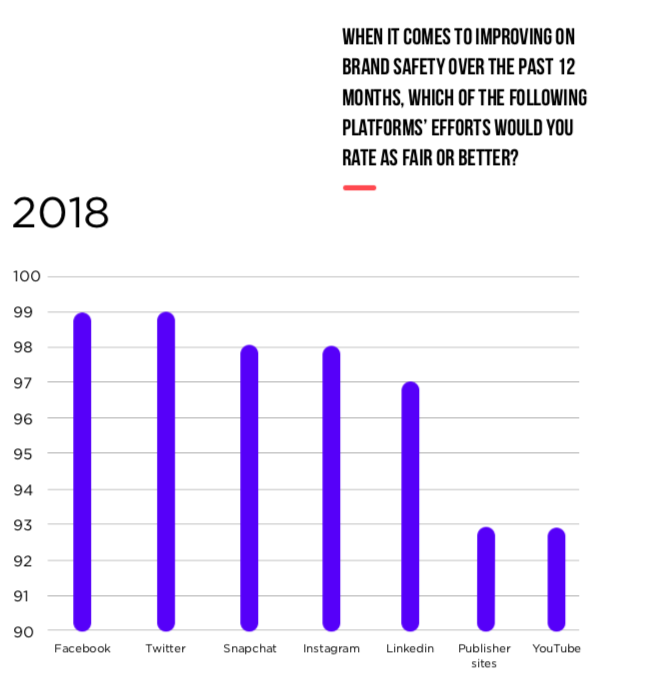Research: These popular brand-safety tactics may be slashing audience reach

In November 2018, Digiday conducted a survey of 274 industry pros from brands, agencies and publishers. We found that most marketers are at least somewhat pleased with the steps that prominent social media platforms have taken to address brand safety since 2017.
Click here to download our full report on brand safety.

Twitter: a clean bill of health
Twitter, which has spent the past year booting unsavory and fraudulent accounts, was rated as the least hazardous environment:
- In our 2017 survey, only one percent of respondents cited Twitter as the most brand-safe social platform platform
- In 2018 percent, the number was 45 percent — a significant plurality of respondents.
Last year, LinkedIn came out on top. Of course, we’re likely not experiencing a fall from grace on the part of the career platform; the shift likely speaks well of Twitter, not poorly of LinkedIn—only four percent of respondents called the latter a brand-unsafe platform this year.
For Twitter, its progress is a symptom of a larger trend: Social platforms have spent much of the past year booting controversial accounts (e.g. Infowars) from their platforms. Some users may not have approved — but marketers did.
Overtreatment
62 percent of respondents said that blacklists — pre-prepared lists of sites where marketers’ ads can’t run — have been their most effective brand safety treatment over the past year, up from 50 percent a year ago. But 69 percent said that using some prominent brand safety tactics, including blacklisting and whitelisting, have inoculated their brands against reaching specific audiences. Last year it was only 30 percent.
Innovative therapies
Computer vision, also known as image recognition, may be the most promising technology when it comes to treating brand safety episodes. It can analyze and identify objects with extreme accuracy. In many ways, image recognition is a cure while blacklisting and whitelisting are merely palliative measures; it enables marketers to venture into seemingly unsafe publisher territory without fear.
31 percent of respondents cited image recognition as amongst their most effective technologies when it comes to mitigating brand safety concerns. A year ago, it was 18 percent. In other words, many of the respondents who were already using it a year ago are now more convinced of its value.
More from Digiday

What does the Omnicom-IPG deal mean for marketing pitches and reviews?
Pitch consultants predict how the potential holdco acquisition could impact media and creative reviews heading into the new year.

AdTechChat organizers manage grievances amid fallout of controversial Xmas party
Community organizers voice regret over divisive entertainment act at London-hosted industry party, which tops a list of grievances.

X tries to win back advertisers with self-reported video stats
Is X’s big bet on video real growth or just a number’s game?






